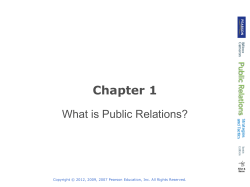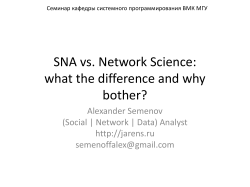
Medical Sociology Chapter 1 Twelfth Edition William C. Cockerham
Medical Sociology Twelfth Edition William C. Cockerham Chapter 1 Medical Sociology Copyright ©2012 by Pearson Education, Inc. All rights reserved. Introduction What do medical sociologists study? – Social causes and patterns of health and disease – Social behavior of health care personnel and their patients – Social functions of health organizations and institutions – Relationship of health care delivery systems to other social systems Important field of study because: – Recognizes the critical role social factors play in determining or influencing the health of individuals, groups, and the larger society. Copyright ©2012 by Pearson Education, Inc. All rights reserved. The Development of Medical Sociology • Most early works were written by physicians focused on the connections between social conditions and health • Early sociologists did not give much attention to matters of health and medicine • Federal funding after WWII gaves sociomedical research a boost – Early collaborations with psychiatry (e.g., the Hollingshead & Redlich 1958 New Haven study, and the Srole et al. 1962 Midtown Manhattan study) – Funding forces an early emphasis on applied research Copyright ©2012 by Pearson Education, Inc. All rights reserved. The Development of Medical Sociology Talcott Parsons – Publishes The Social System in 1951 – First major social theorist to deal with issues of health, illness, and the role of medicine – Structural-functionalist perspective – Introduced concept of the sick role • A patterned set of expectations defining the norms and values appropriate to being sick Copyright ©2012 by Pearson Education, Inc. All rights reserved. The Development of Medical Sociology Practical application versus theory – Robert Straus (1957) notes division between sociology in medicine and sociology of medicine • Division found mostly in the U.S. • Initial tension between areas resolved by: – Orientation of most research (whether in medicine or in sociology) toward practical application due to funding pressures – Convergence with main discipline of sociology: regardless of area, all sociologists receive same training; increased use of sociological theory in medical sociology Copyright ©2012 by Pearson Education, Inc. All rights reserved. Defining Health World Health Organization (WHO) definition: – A state of complete physical, mental, and social well-being, and not merely the absence of disease or injury Laypersons tend to view health as the capacity to carry out their daily activities – Health as the ability to function Copyright ©2012 by Pearson Education, Inc. All rights reserved. Contrasting Ideas about Health and Social Behavior • Primitive humans tended to rely on magic as the fundamental explanation of disease and illness • Hippocrates of ancient Greece represents first attempt to base understanding of the body on rational thought; recognizes contribution of the environment to human well-being • Middle Ages introduces a split in responsibility for human well-being: Church attends to social needs while physicians focus on physical ailments Copyright ©2012 by Pearson Education, Inc. All rights reserved. Contrasting Ideas about Health and Social Behavior Modern medicine and regulation of the body (late 18th century) – Michel Foucault (1973) describes development of modern medicine and notes split between two trends: • Medicine of the species gave strong emphasis on classifying diseases, diagnosing and treating patients, and finding cures • Medicine of social spaces was concerned with preventing disease, especially through government involvement in matters of public hygiene – Modern medicine rejects supernatural explanations for disease and treats it as an object to be studied, confronted scientifically, and controlled Copyright ©2012 by Pearson Education, Inc. All rights reserved. Contrasting Ideas about Health and Social Behavior The public’s health (19th century) – Systematic implementation of public health measures and improvements in public sanitation – Period sees declining mortality rates from infectious diseases • Improvements in population’s health mainly due to improvements in diet, housing, public sanitation, and personal hygiene instead of medical innovations (McKeown 1979; Porter 1997). Copyright ©2012 by Pearson Education, Inc. All rights reserved. Contrasting Ideas about Health and Social Behavior Germ theory of disease (late 19th-20th century) • Biomedical approach: every disease has a specific pathogenic cause best treated by removing or controlling that cause • Medical practice gives little attention to social causes of health and instead focuses on treating disease and illness with drugs Copyright ©2012 by Pearson Education, Inc. All rights reserved. Contrasting Ideas about Health and Social Behavior “Whole person” health care (late 20th-21st century) – Transition from infectious to chronic diseases as leading causes of death (epidemiological transition) around mid-20th century – Recognition that social environment and lifestyle practices influence chronic diseases encourages emphasis in medicine on treating the “whole person” Copyright ©2012 by Pearson Education, Inc. All rights reserved. The Reemergence of Infectious Diseases Three epidemiological transitions in human history (Armelagos and Harper 2010): • First - occurred around 10,000 years ago – Human societies shifted from foraging (hunting and gathering) to agriculture – Marked by the emergence of novel infectious and nutritional diseases • Second - about 200 years ago – Improved nutrition and living standards, public health measures, and medical advances in developed societies led to a decline in infectious diseases and a rise in chronic and degenerative diseases • Third – beginning now – Resurgence of infectious diseases previously thought to be under control – The potential for the spread of infectious diseases has been significantly enhanced in today’s world by the globalization of trade and travel Copyright ©2012 by Pearson Education, Inc. All rights reserved. The Reemergence of Infectious Diseases West Nile virus – First appeared in New York City in the summer of 1999 – Initially puzzled medical personnel and public health officials, since the disease had not been seen before in the Western hemisphere – Eventually spread throughout the U.S. – Peak cases/mortality in 2006 Copyright ©2012 by Pearson Education, Inc. All rights reserved. The Reemergence of Infectious Diseases Sexually transmitted diseases – Represents greatest threat to worldwide health – Four factors responsible for dramatic increase in rates: • (1) Birth control pill reduced fears of unwanted pregnancy • (2) Ideology of sexual liberation and permissiveness among young urban adults throughout the world • (3) New pattern of migrant employment in developing nations spreads STDs acquired in urban areas to the countryside • (4) Availability of multiple sexual partners – Most important risk factor in exposure to infection Copyright ©2012 by Pearson Education, Inc. All rights reserved. The Reemergence of Infectious Diseases Bioterrorism – Relatively new threat of infectious diseases – Takes place when people knowingly prepare biological agents or gases and use them to deliberately induce illness and death among other people • Overt - the perpetrator announces responsibility for the event or is revealed by the attack • Covert - characterized by the unannounced or unrecognized release of agents; the presence of sick people may be the first sign of an attack – Examples: • 1995 release of sarin gas in Japan by the Aum Shinrikyo cult in the Tokyo subway • 1996 outbreak of gastroenteritis when a disgruntled coworker put dysentery bacteria in pastries consumed by staff members in a large medical center laboratory • 2001 anthrax sent through the U.S. mail Copyright ©2012 by Pearson Education, Inc. All rights reserved. Bioethics • Area of study focused on ethical decisions and practices with respect to medical care, research, and human’s rights over their bodies • Medical decisions can have profound social implications – May reflect discrimination and prejudice against particular social groups • Important cases of unethical behavior, spurring development of regulations: – Nazi experiments – Tuskegee Syphilis Study in Alabama in 1932 • Institutional review boards (IRBs) responsible for oversight of research: – Fully informed voluntary patient consent, acceptable risk–benefit ratios, guaranteed patient anonymity and confidentiality • Health Insurance Portability and Accountability Act (HIPAA) of 1996 – Regulates the handling of patient data and privacy Copyright ©2012 by Pearson Education, Inc. All rights reserved. Bioethics • Also concerned with controversial areas of medical practice and research: – Funding of research by pharmaceutical companies – Practices such as “ghost-writing” academic articles on the use of medical interventions – Stem cell research – Use of human genetic material, including cloning – Abortion – Euthanasia – Reproductive technology Copyright ©2012 by Pearson Education, Inc. All rights reserved.
© Copyright 2025














